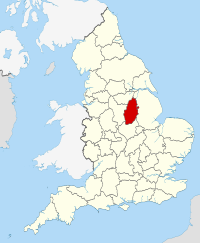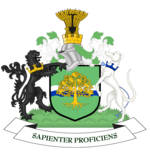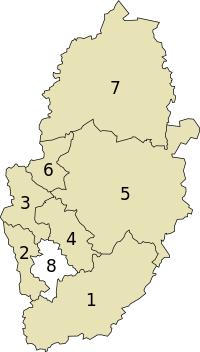Nottinghamshire

Multi tool use
Coordinates: 53°10′N 1°00′W / 53.167°N 1.000°W / 53.167; -1.000
| Nottinghamshire | |||
|---|---|---|---|
County | |||
| |||
Motto: Sapienter proficiens (Progress with wisdom) | |||
 Nottinghamshire in England | |||
| Sovereign state | |||
| Country | |||
| Region | East Midlands |
||
| Established | Historic |
||
| Ceremonial county | |||
| Lord Lieutenant | Sir John Peace |
||
| High Sheriff | Nicholas R B Ebbs [1] (2018/19) |
||
| Area | 2,160 km2 (830 sq mi) |
||
| • Ranked | 27th of 48 |
||
| Population (mid-2017 est.) | 1,147,100 |
||
| • Ranked | 15th of 48 |
||
| Density | 531/km2 (1,380/sq mi) |
||
| Ethnicity | 94.1% White British/Irish/Other 2.5% South Asian 1.5% Afro-Caribbean |
||
| Non-metropolitan county | |||
| County council |  Nottinghamshire County Council Nottinghamshire County Council |
||
| Executive | Labour |
||
| Admin HQ | West Bridgford |
||
| Area | 2,085 km2 (805 sq mi) |
||
| • Ranked | 24th of 27 |
||
| Population | 817,900 |
||
| • Ranked | 10th of 27 |
||
| Density | 392/km2 (1,020/sq mi) |
||
| ISO 3166-2 | GB-NTT |
||
| ONS code | 37 |
||
| NUTS | UKF15/16 |
||
| Website | www.nottinghamshire.gov.uk |
||
 Districts of Nottinghamshire | |||
| Districts |
|
||
| Members of Parliament |
|
||
| Police | Nottinghamshire Police |
||
| Time zone | Greenwich Mean Time (UTC) |
||
| • Summer (DST) | British Summer Time (UTC+1) |
||
Nottinghamshire (pronounced /ˈnɒtɪŋəmʃər/ or /-ʃɪər/;[2] abbreviated Notts) is a county in the East Midlands region of England, bordering South Yorkshire to the north-west, Lincolnshire to the east, Leicestershire to the south, and Derbyshire to the west. The traditional county town is Nottingham, though the county council is based in West Bridgford in the borough of Rushcliffe, at a site facing Nottingham over the River Trent.
The districts of Nottinghamshire are Ashfield, Bassetlaw, Broxtowe, Gedling, Mansfield, Newark and Sherwood, and Rushcliffe. The City of Nottingham was administratively part of Nottinghamshire between 1974 and 1988, but is now a unitary authority,[2] remaining part of Nottinghamshire for ceremonial purposes.
In 2017, the county was estimated to have a population of 785,800.
Over half of the population of the county live in the Greater Nottingham conurbation (which continues into Derbyshire).[3] The conurbation has a population of about 650,000, though less than half live within the city boundaries.[citation needed]
Contents
1 History
2 Physical geography
2.1 Green belt
3 Politics
3.1 Westminster Parliamentary
3.2 Political control
4 Economy and industry
5 Education
5.1 Secondary education
5.2 Higher education
6 Culture
7 Settlements and communications
8 Places of interest
9 See also
10 References
11 External links
History
Nottinghamshire lies on the Roman Fosse Way, and there are Roman settlements in the county; for example at Mansfield, and forts such as at the Broxtowe Estate in Bilborough. The county was settled by Angles around the 5th century, and became part of the Kingdom, and later Earldom, of Mercia. However, there is evidence of Saxon settlement at the Broxtowe Estate, Oxton, near Nottingham, and Tuxford, east of Sherwood Forest. The name first occurs in 1016, but until 1568, the county was administratively united with Derbyshire, under a single Sheriff. In Norman times, the county developed malting and woollen industries. During the industrial revolution, the county held much needed minerals such as coal and iron ore, and had constructed some of the first experimental waggonways in the world; an example of this is the Wollaton wagonway of 1603-1616, which transported minerals from bell pitt mining areas at Strelley and Bilborough, this led to canals and railways being constructed in the county, and the lace and cotton industries grew. In the 18th and 19th centuries, mechanised deeper collieries opened, and mining became an important economic sector, though these declined after the 1984–85 miners' strike.
Until 1610, Nottinghamshire was divided into eight Wapentakes. Sometime between 1610 and 1719, they were reduced to six – Newark, Bassetlaw, Thurgarton, Rushcliffe, Broxtowe, and Bingham, some of these names still being used for the modern districts. Oswaldbeck was absorbed in Bassetlaw, of which it forms the North Clay division, and Lythe in Thurgarton.
Nottinghamshire is famous for its involvement with the legend of Robin Hood. This is also the reason for the numbers of tourists who visit places like Sherwood Forest, City of Nottingham, and the surrounding villages in Sherwood Forest. To reinforce the Robin Hood connection, the University of Nottingham in 2010 has begun the Nottingham Caves Survey, with the goal "to increase the tourist potential of these sites". The project "will use a 3D laser scanner to produce a three dimensional record of more than 450 sandstone caves around Nottingham".[4]
Nottinghamshire was mapped first by Christopher Saxton in 1576; the first fully surveyed map of the county was by John Chapman, who produced Chapman's Map of Nottinghamshire in 1774.[5] The map was the earliest printed map at a sufficiently useful scale (one statute mile to one inch) to provide basic information on village layout, and the existence of landscape features such as roads, milestones, tollbars, parkland, and mills.
Physical geography
 [Full screen] |
| Interactive map of Nottinghamshire and city/districts |
Nottinghamshire, like Derbyshire, and South Yorkshire, sits on extensive coal measures, up to 900 metres (3,000 feet) thick, and occurring largely in the north of the county. There is an oilfield near Eakring. These are overlaid by sandstones and limestones in the west, and clay in the east.[6] The north of the county is part of the Humberhead Levels lacustrine plain. The centre and south west of the county, around Sherwood Forest, features undulating hills with ancient oak woodland. Principal rivers are the Trent, Idle, Erewash, and Soar. The Trent, fed by the Soar, Erewash, and Idle, composed of many streams from Sherwood Forest, run through wide and flat valleys, merging at Misterton. A point just north of Newtonwood Lane, on the boundary with Derbyshire is the highest point in Nottinghamshire; at 205 metres (673 feet),[7] while Silverhill, a spoil heap left by the former Silverhill colliery, a man-made point often cited as the highest, reaches 204 metres (669 feet). The lowest is Peat Carr, east of Blaxton, at sea level; the Trent is tidal below Cromwell Lock.[8]
Nottinghamshire is sheltered by the Pennines to the west, so receives relatively low rainfall at 641 to 740 millimetres (25 to 29 inches) annually.[9] The average temperature of the county is 8.8–10.1 degrees Celsius (48–50 degrees Fahrenheit).[10] The county receives between 1321 and 1470 hours of sunshine per year.[11]
Green belt
Nottinghamshire contains one green belt area, first drawn up from the 1950s. Completely encircling the Nottingham conurbation, it stretches for several miles into the surrounding districts, and extends into Derbyshire.
Politics
Nottinghamshire is represented by eleven (11) members of parliament (MP); of which six are members of the Labour Party, and five are Conservatives. Kenneth Clarke of Rushcliffe is a former Conservative Chancellor of the Exchequer and Lord High Chancellor.
Following the 2017 County Council elections, the County Council is controlled by a coalition of Conservatives and Mansfield Independent Forum, having taken control from the Labour administration. The seats held are 31 Conservatives, 23 Labour, 11 Independents, 1 Liberal Democrat. In the previous 2013 election, the County Council was Labour controlled, a gain from the Conservatives.
Local government is devolved to seven local borough and district councils. Ashfield, Bassetlaw, Gedling, and Mansfield are Labour controlled; while Broxtowe, Newark and Sherwood, and Rushcliffe are Conservative controlled.
Westminster Parliamentary
| General Election 2017: Nottinghamshire | ||||||
|---|---|---|---|---|---|---|
| Labour | Conservative | Liberal Democrats | UKIP | Green | others | turnout |
| 265,073 +59,165 |
242,451 +52,410 |
16,018 -7,337 |
15,922 −61,126 |
5,718 -13,217 |
6,900 +5,017 |
552,082 +35,382 |
| overall number of seats in 2017 | |||||
|---|---|---|---|---|---|
| Labour | Conservative | Liberal Democrats | UKIP | Green | others |
| 6 |
5 |
0 |
0 |
0 |
0 |
Political control
Nottinghamshire is a non-metropolitan county, governed by Nottinghamshire County Council and seven non-metropolitan district councils. Elections to the county council take place every four years, with the first election taking place in 1973. Following each election, the county council has been controlled by the following parties:[12]
| year |
party |
details |
|
|---|---|---|---|
1973 |
Labour |
details |
|
1977 |
Conservative |
details |
|
1981 |
Labour |
details |
|
1985 |
Labour |
details |
|
1989 |
Labour |
details |
|
1993 |
Labour |
details |
|
1997 |
Labour |
details |
|
2001 |
Labour |
details |
|
2005 |
Labour |
details |
|
2009 |
Conservative |
details |
|
2013 |
Labour |
details |
|
2017 |
no overall control |
details |
|
Economy and industry
The regional economy was traditionally based on industries such as coal mining in the Leen Valley, and manufacturing. Since the invention of the knitting frame by local William Lee, the county, in particular Nottingham, became synonymous with the lace industry.[13]
In 1998, Nottinghamshire had a gross domestic product (GDP) per-capita of £12,000, and a total GDP of £12,023 million. This is compared to a per-capita GDP of £11,848 for the East Midlands, £12,845 for England, and £12,548 for the United Kingdom. Nottingham has a GDP per-capita of £17,373, North Nottinghamshire £10,176, and South Nottinghamshire £8,448.[14] In October 2005, the United Kingdom had 4.7% unemployment, the East Midlands 4.4%, and the Nottingham commuter belt area 2.4%.[15]
Education
Secondary education
The county has comprehensive secondary education with 47 state secondary schools, as well as 10 independent schools. The City of Nottingham local education authority (LEA) has 18 state schools and 6 independent schools, not including sixth form colleges.
9,700 pupils took GCSEs in the Nottinghamshire LEA in 2007. The best results were from the West Bridgford School, closely followed by Rushcliffe Comprehensive School and the Minster School in Southwell. The lowest performing school was the Queen Elizabeth's Endowed School in Mansfield. In Nottingham, the best results came from the Trinity Catholic School and the Fernwood School in Wollaton.
At A-level, the highest performing institution was The Becket School, followed by the West Bridgford School. Some of the county's best results tend to come from Nottingham High School, closely followed by the all-female Nottingham High School for Girls, both of which are privately run.
Higher education
The University of Nottingham is a Russell Group university and well-renowned, offering one of the broadest selections of courses in the UK. Nottingham Trent University is one of the most successful post-1992 universities in the UK. Both universities combine to make Nottingham one of England's largest student cities. Nottingham Trent University also has an agricultural college near Southwell, while the University of Nottingham has one at Sutton Bonington.

National and County cricket player Harold Larwood
Culture
Nottinghamshire contains the ancestral home of the poet Lord Byron, Newstead Abbey, which he sold in 1818. It is now owned by Nottingham City Council, and is open to the public. The acclaimed author D. H. Lawrence was from Eastwood in Nottinghamshire. Toton was the birthplace and home of English folk singer-songwriter Anne Briggs, well known for her song Black Waterside. The north of the county is also noteworthy for its connections with the Pilgrim Fathers. William Brewster, for example, came from the village of Scrooby, and was influenced by Richard Clyfton, who preached at Babworth.
Nottinghamshire County Cricket Club (NCCC) are a first class county cricket club who play at Trent Bridge in West Bridgford. They won the County Championship in 2010. The most successful football team within Nottinghamshire is Nottingham Forest, a Championship club that won the 1978 English championship, and followed it up with winning the 1979 and 1980 European Cup titles. Notts County, currently in League Two, and Mansfield Town, also a League Two side are other professional teams from the area. Other notable sporting teams are the Nottingham Rugby Football Club, and the Nottingham Panthers Ice Hockey Club.
Nottinghamshire has international twinning arrangements with the province of Wielkopolska (Greater Poland) in western Poland, and with the province's capital city, Poznań.[16]
Settlements and communications

The council house and a tram in Nottingham market square
The traditional county town, and the largest settlement in the historic and ceremonial county boundaries, is the City of Nottingham. The City is now administratively independent, but suburbs including Arnold, Carlton, West Bridgford, Beeston, and Stapleford are still within the administrative county, and West Bridgford is now home of the county council.
There are several market towns in the county. Newark-on-Trent is a bridging point of the Fosse Way and River Trent, but is actually an Anglo-Saxon market town with a now ruined castle. Mansfield, the second-largest settlement in the county, sits on the site of a Roman settlement, but grew after the Norman Conquest. Worksop, in the north of the county, is also an Anglo-Saxon market town which grew rapidly in the industrial revolution, with the arrival of canals and railways and the discovery of coal. Other market towns include Arnold, Bingham, Hucknall, Kirkby-in-Ashfield, and Retford.
The main railway in the county is the Midland Main Line, which links London to Sheffield via Nottingham. The Robin Hood Line between Nottingham and Worksop serves several villages in the county. The East Coast Main Line from London to Doncaster, Leeds, York, Newcastle-upon-Tyne, and Scotland serves the eastern Nottinghamshire towns of Newark and Retford.
The M1 motorway runs through the county, connecting Nottingham to London, Leeds, and Leicester by road. The A1 road follows for the most part the path of the Great North Road, although in places it diverges from the historic route where towns have been bypassed. Retford was by-passed in 1961, and Newark-on-Trent was by-passed in 1964, and the A1 now runs between Retford and Worksop past the village of Ranby. Many historic coaching inns can still be seen along the traditional route.
East Midlands Airport is just outside the county in Leicestershire, while Doncaster Sheffield Airport lies within the historic boundaries of Nottinghamshire. These airports serve the county and several of its neighbours. Together, the airports have services to most major European destinations, and East Midlands Airport now also has services to North America and the Caribbean. As well as local bus services throughout the county, Nottingham and its suburbs have a tram system, Nottingham Express Transit.
Places of interest
- Attenborough Nature Reserve
- Clumber Park
- Creswell Crags
- The Harley Gallery
Hawton Church- Newstead Abbey
- Nottingham Castle
- Rufford Country Park
- Rushcliffe Country Park
- Sherwood Forest
- Sherwood Observatory
- Southwell Minster
- Welbeck Abbey
- Wollaton Hall
- Wollaton Park
- Ye Olde Trip To Jerusalem
See also
- Lord Lieutenant of Nottinghamshire
- High Sheriff of Nottinghamshire
- Nottinghamshire Police
- Nottinghamshire Police and Crime Commissioner
References
^ "No. 62229". The London Gazette. 15 March 2018. pp. 4814–4814..mw-parser-output cite.citation{font-style:inherit}.mw-parser-output q{quotes:"""""""'""'"}.mw-parser-output code.cs1-code{color:inherit;background:inherit;border:inherit;padding:inherit}.mw-parser-output .cs1-lock-free a{background:url("//upload.wikimedia.org/wikipedia/commons/thumb/6/65/Lock-green.svg/9px-Lock-green.svg.png")no-repeat;background-position:right .1em center}.mw-parser-output .cs1-lock-limited a,.mw-parser-output .cs1-lock-registration a{background:url("//upload.wikimedia.org/wikipedia/commons/thumb/d/d6/Lock-gray-alt-2.svg/9px-Lock-gray-alt-2.svg.png")no-repeat;background-position:right .1em center}.mw-parser-output .cs1-lock-subscription a{background:url("//upload.wikimedia.org/wikipedia/commons/thumb/a/aa/Lock-red-alt-2.svg/9px-Lock-red-alt-2.svg.png")no-repeat;background-position:right .1em center}.mw-parser-output .cs1-subscription,.mw-parser-output .cs1-registration{color:#555}.mw-parser-output .cs1-subscription span,.mw-parser-output .cs1-registration span{border-bottom:1px dotted;cursor:help}.mw-parser-output .cs1-hidden-error{display:none;font-size:100%}.mw-parser-output .cs1-visible-error{font-size:100%}.mw-parser-output .cs1-subscription,.mw-parser-output .cs1-registration,.mw-parser-output .cs1-format{font-size:95%}.mw-parser-output .cs1-kern-left,.mw-parser-output .cs1-kern-wl-left{padding-left:0.2em}.mw-parser-output .cs1-kern-right,.mw-parser-output .cs1-kern-wl-right{padding-right:0.2em}
^ ab "Definition of 'Nottinghamshire' – British English pronunciation". www.CollinsDictionary.com. Collins English Dictionary. Retrieved 23 December 2017.
^ "Council chief bans use of 'Greater Nottingham' for 'Core City Area'". Telegraph.co.uk. Telegraph Media Group Limited. 23 June 2010. Retrieved 25 September 2010.
^ "Laser to scan Robin Hood's prison under Nottingham city". news.BBC.co.uk. BBC News. 20 April 2010. Retrieved 25 September 2010.
^ Chapman's Map of Nottinghamshire 1774. Nottinghamshire County Council
ISBN 0-902751-46-8.
^ Chisholm, Hugh, ed. (1911). "Nottinghamshire § Geology". Encyclopædia Britannica (11th ed.). Cambridge University Press. p. 827.
Chisholm, Hugh, ed. (1911). "Nottinghamshire § Geology". Encyclopædia Britannica (11th ed.). Cambridge University Press. p. 827.
^ Barnard, John (8 February 2011). "Survey of highest point Nottinghamshire (final)". www.Hill-Bagging.co.uk. Database of British and Irish Hills. Retrieved 20 March 2012.
^ Haran, Brady. "Experiencing the Highs and Lows". news.BBC.co.uk. BBC News. Retrieved 28 September 2015.
^ "Annual average rainfall for the United Kingdom". www.MetOffice.com. Met Office. 2000. Archived from the original on 4 March 2010.
^ "Annual average temperature for the United Kingdom". www.MetOffice.com. Met Office. 2000. Archived from the original on 4 March 2010.
^ "Annual average sunshine for the United Kingdom". www.MetOffice.com. Met Office. 2000. Archived from the original on 4 March 2010.
^ "Nottinghamshire local elections". news.BBC.co.uk. BBC News Online. 19 April 2009. Retrieved 25 September 2009.
^ Sheila A. Mason, BA (Hons), FRSA (2004). "Legacies – Nottingham – Black lead and bleaching – the Nottingham lace industry". www.BBC.co.uk. BBC. Retrieved 23 December 2017.CS1 maint: Multiple names: authors list (link)
^ "Regional Trends 26, chapter 14.7" (PDF). www.Statistics.gov.uk. Office for National Statistics. 2001. Archived from the original (PDF) on 22 December 2003. Retrieved 24 December 2005.
^ "Labour market statistics for October 2005". www.EastMidlandsObservatory.org.uk. East Midlands Observatory. 2005. Archived from the original on 12 March 2016. Retrieved 24 December 2005.
^ "Transnational partnerships". www.Nottinghamshire.gov.uk. Nottinghamshire County Council.
External links
| Wikimedia Commons has media related to Nottinghamshire. |
| Wikivoyage has a travel guide for Nottinghamshire. |
Nottinghamshire Heritage Gateway — essays on local history by experts; covers places, people, themes and events.- Visit Nottinghamshire
- Nottinghamshire County Council
6UIH vStQ6uggK5nV6i8CZjII3TOsQWUgRzN,ggOdbPplBMUa1K7BJoOuveZ
